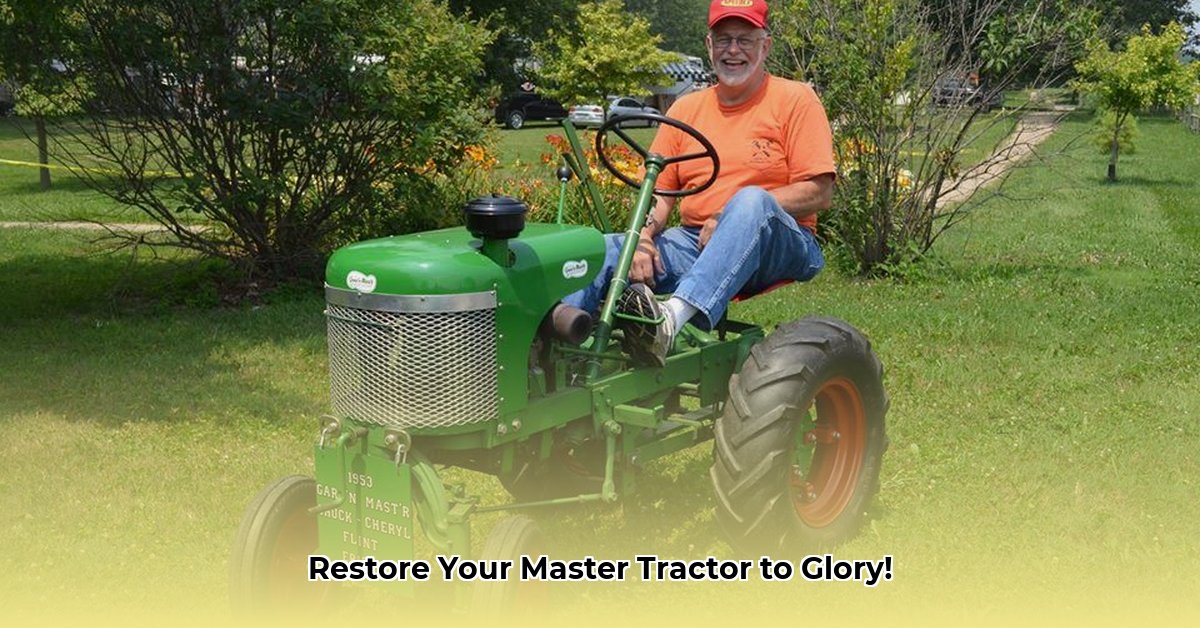
Unearthing Your Garden Master Tractor Treasure
The allure of a perfectly restored Garden Master tractor is undeniable. These classic machines, produced by Garden-All Inc., offer a unique blend of charm and functionality. However, the path to ownership and restoration is rarely straightforward. Parts are scarce, reliable information is limited, and accurately assessing value presents a challenge. This comprehensive guide addresses these hurdles, providing practical steps and valuable insights for collectors of all experience levels. Are you ready to embark on this rewarding journey? For more on classic tractor specs, check out this helpful resource on tractor specifications.
Identifying Your Garden Master: The Model Matters
Before you begin, accurately identifying your Garden Master model is paramount. The two primary models are the 8hp Model G (often simply called "Garden Master") and the 6hp Model JR. Distinguishing between them is crucial for sourcing correct parts, understanding its value, and creating a tailored restoration plan. Carefully examine the engine and chassis for model markings—these subtle clues provide valuable information. Note the engine type (Wisconsin or Briggs & Stratton) as this significantly affects parts compatibility and restoration strategies. This initial identification step forms the foundation of your restoration project.
Giving Your Garden Master a Once-Over: A Detailed Inspection
Before any restoration work begins, conduct a meticulous inspection of your tractor. Think of yourself as a detective examining a crime scene—every detail counts! What is the condition of the engine (running, seized, missing parts)? Is the transmission functioning correctly? Are the tires worn or damaged? Document any rust, dents, or imperfections in the bodywork. The more comprehensive your initial assessment, the better prepared you'll be for the restoration process.
A systematic approach using a checklist ensures thoroughness. Here's a sample:
| Component | Condition Assessment | Notes |
|---|---|---|
| Engine | Running condition, needs tune-up, seized, missing parts? | Note engine type (Briggs & Stratton or Wisconsin) and model number. |
| Transmission | Smooth shifting, needs adjustment, non-functional? | Test each gear meticulously, noting any issues. |
| Tires | Tread depth, cracks, inflation. | Plan for tire replacement as needed. |
| Bodywork | Rust, dents, paint condition. | Note original paint remaining and document any damage. |
| Accessories | Plow, cultivator, mower deck—condition and completeness. | List missing components for future sourcing. |
The Great Parts Hunt: Sourcing Components for Your Garden Master
Securing original Garden Master parts often proves the most significant challenge. Online forums dedicated to vintage tractors are invaluable resources, offering a wealth of information and connections with fellow enthusiasts. These online communities function as support networks, providing advice and assisting in parts acquisition. Don't overlook used parts; these can be cost-effective alternatives, even if they need some attention. Junkyards, too, can be surprisingly fruitful hunting grounds. Remember, creative problem-solving and resourcefulness often play a crucial role in successful restoration. "I've found that the most challenging aspect is sourcing parts," says John Miller, a renowned vintage tractor restoration expert.
Your Garden Master Restoration: A Step-by-Step Guide
The restoration itself requires a systematic, phased approach. Remember, patience is key!
Deep Clean: Begin with a thorough cleaning to assess the extent of damage and plan subsequent steps. (This typically takes 4-6 hours, depending on the tractor's condition).
Engine Action: Address engine issues (repair or replacement). This often dictates the project timeline and budget. (Engine work can range from a few hundred dollars for a tune-up to thousands for a complete rebuild).
Transmission Tune-Up: Evaluate and restore transmission functionality. (Expect to allocate 8-12 hours for a thorough transmission inspection and repair, potentially more for major issues).
Bodywork Bliss: Repair rust, dents, and repaint (matching the original color if aiming for a show-quality restoration). (Bodywork can consume 20+ hours, depending on the level of damage and the chosen paint finish).
Reassembly Rhapsody: Carefully reassemble the tractor, utilizing your detailed notes and photographs. Seek assistance when needed. (Reassembly often takes as long—and sometimes longer—than disassembly; accurate documentation is critical).
The Power of Community: Connecting with Fellow Garden Master Enthusiasts
Joining online forums and collector clubs is crucial. These communities are invaluable sources of information, support, and camaraderie. Networking with other enthusiasts creates opportunities for parts acquisition, advice, and assistance throughout the restoration journey.
Valuing Your Garden Master: A Look at Market Trends
The value of a restored Garden Master depends on several factors: its condition, originality, and included accessories. While online marketplaces offer general price guidance, precise valuation is difficult. A meticulously documented restoration history significantly enhances its value. The value of a fully restored, original Garden Master can be substantial; this makes careful record-keeping a crucial aspect of any restoration project.
Remember, restoring a Garden Master is a journey of discovery, patience, and perseverance. The end result – a beautifully restored machine—is a rewarding testament to your skill and dedication.